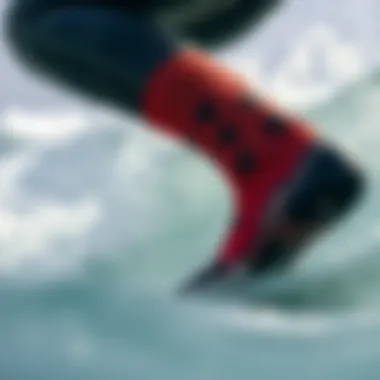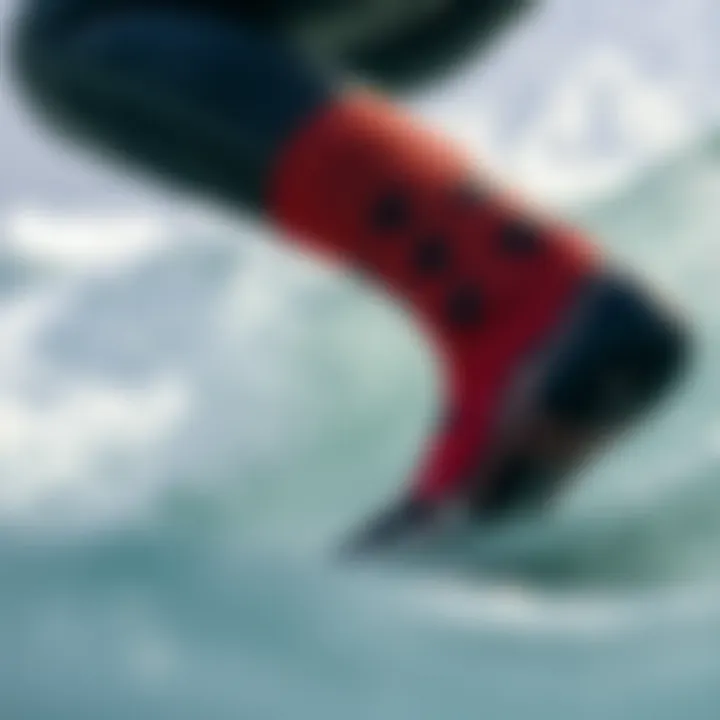Wetsuit Socks for Surfing: A Comprehensive Exploration


Intro
Wetsuit socks are often regarded as an afterthought in the toolkit of surfers. While boards, wetsuits, and fins often bathe in the spotlight, the humble wetsuit sock can significantly affect a surfer's experience in the water. Whether you're riding waves in chilly waters or just trying to keep your feet from freezing, these socks play an essential role in protecting and enhancing performance.
Understanding the significance of wetsuit socks also means discussing how they can influence comfort and endurance during your surf sessions. They help maintain warmth and reduce fatigue, allowing surfers to stay out longer in the surf without losing feeling in their toes. But wearers must also choose wisely, factoring in style, material, and fit – because, let’s face it, the last thing you need while trying to concentrate on catching that perfect wave is a sock that doesn't fit right.
In this exploration, we will dive into various aspects of wetsuit socks, from material innovations that push comfort and utility boundaries to the maintenance practices that ensure longevity. We’ll also dissect different styles to suit varied surf conditions and skill levels, empowering both newcomers and seasoned surfers alike to make informed choices about their ocean gear.
Let’s embark on this journey to discover the ins and outs of wetsuit socks to help elevate your surfing experience!
Prologue to Wetsuit Socks
Wetsuit socks might not seem like the star of the show when it comes to surfing gear, but their significance is undeniably profound. In the grand tapestry of surfing accessories, these socks weave together warmth, comfort, and function. For both seasoned shredders and newcomers to the surf culture, wetsuit socks fill a niche that is often overlooked yet vital. Offering thermal insulation, they help maintain body heat in chilly waters, providing that much-needed edge during extended surf sessions.
Definition and Purpose
Wetsuit socks are specialized footwear designed to be worn with wetsuits when surfing, kayaking, or engaging in similar water sports. The primary purpose of these socks is to keep the feet warm and protected from colder ocean waters, yet they also serve additional functions. Apart from thermal insulation, they aim to enhance grip on the board, foster better balance, and offer protection against abrasive surfaces beneath the water, such as barnacle-encrusted rocks.
When surfers find themselves in waters that match the chill of a polar bear’s pool party, donning a pair of well-fitted wetsuit socks becomes paramount. These socks occupy the unique space between functional and comfortable, ensuring toes don’t get frostbite while paddling out for those lucrative waves.
Surfer's Footwear: An Overview
In the realm of surfer’s footwear, wetsuit socks stand out by combining advanced materials with practical design. While some may opt for flip-flops or regular water shoes, these often lack the thermal properties and grip essential for effective surfing. Unlike conventional surf booties, which cover the entire foot, wetsuit socks offer a less constrictive alternative, letting the wearer maneuver their toes while still offering a secure fit. Additionally, they are typically thinner, allowing for improved dexterity when adjusting one's footing on the board.
The materials used in wetsuit socks usually consist of neoprene, which provides a snug fit that acts like a second skin. This minimizes water entry but maximizes warmth. Wetsuit socks can vary in thickness, style, and design, catering to different surfing conditions and personal preferences.
"A great pair of wetsuit socks can turn an uncomfortable surf session into a joyride, preserving body heat when the ocean temperature feels like liquid ice."
In essence, investing in wetsuit socks plays a critical role in enhancing the overall surfing experience. It's not just about performance; it’s also about comfort and safety. For kiteboarders, adventure seekers, and outdoor instructors, understanding the intricate details of wetsuit socks is indispensable, equipping them with the knowledge to make informed choices for their gear.
Materials Used in Wetsuit Socks
When it comes to wetsuit socks, the materials selected play a major role in their performance and functionality. Understanding the different components helps surfers make informed decisions to enhance their overall beach experience. The main materials used in wetsuit socks directly affect factors such as comfort, durability, thermal insulation, and flexibility. Let's take a closer look at the key materials that make up these essential surfing accessories.
Neoprene: The Standard Choice
Neoprene has long been synonymous with wetsuits and, unsurprisingly, it remains the go-to choice for wetsuit socks. This synthetic rubber offers a unique blend of durability and thermal insulation, making it perfect for chilly water conditions.
One of the significant advantages of neoprene is its insulative properties. It minimizes heat loss, keeping your feet warm during those extended surf sessions. Generally, neoprene socks are available in various thicknesses, allowing surfers to adjust according to water temperature.
Moreover, neoprene is remarkably flexible, enabling freedom of movement in the water. Many surfers appreciate this characteristic, as it allows them to feel more in tune with their board. However, it's worth noting that neoprene can degrade over time when exposed to sunlight and saltwater, so proper care is essential.
To illustrate, consider a surfer braving the cold waters of Maine. A 5mm neoprene sock would suffice to keep those toes warm while maintaining a level of grip on the board that helps with balance. Conversely, a surfer in warmer Florida waters might opt for a thinner 2mm option, giving them the best of both worlds: warmth without overheating.
Alternative Materials and Innovations
While neoprene remains the favorite, the world of wetsuit socks is not stagnant. Advancements in materials have introduced alternatives that can cater to diverse preferences and needs.
1. Yamamoto Neoprene: A more eco-friendly version of traditional neoprene, Yamamoto neoprene is derived from limestone rather than petroleum. It provides similar thermal insulation properties but is lighter and more flexible.
2. Padded Wool Blends: Some brands have experimented with a combination of wool and synthetic fibers. This option brings natural insulation to the table while still providing adequate grip. It's an interesting choice for surfers who prefer natural materials and find them more comfortable than rubber variants.
3. 3D Printed Designs: With technology evolving rapidly, some companies have started integrating 3D printing in their production process. This innovation allows for customized fits, supporting unique foot shapes and sizes. It can significantly reduce the chances of discomfort caused by incorrect sizing.
4. Neoprene-Free Materials: A few brands have developed fully neoprene-free options for environmental enthusiasts. These products often utilize recycled materials, providing a fresh take on sustainability in the surfing accessories market.
Choosing the right material plays an integral role in comfort, performance, and pleasure during surfing. Surfers need to balance warmth, flexibility, and sustainability when selecting their wetsuit socks.
"The material matters; it isn’t just about warmth – it’s about how you connect with your board and the ocean".
As technology advances, surfers can expect even more choices tailored to their unique needs, keeping them riding those waves comfortably, no matter the conditions.
Benefits of Using Wetsuit Socks
Wetsuit socks serve a crucial role in a surfer’s gear, playing a part that goes beyond mere aesthetics. In various surf conditions, the right pair of wetsuit socks ensures that one's feet are not only protected from the cold but also enhance overall performance in the water. When the surf rises and the breeze picks up, these socks can be your unsung heroes.
Thermal Protection
One of the most significant advantages of wearing wetsuit socks is the thermal protection they offer. Surfing in chilly waters without insulation can lead to discomfort, distracting you from fully engaging in your ride. The cold can sap your strength, leaving you sluggish and less inclined to push through tougher surf. Wetsuit socks, generally made of neoprene, create a barrier that retains body heat, significantly reducing the risk of hypothermia.
Cold water can numb your feet, leading to loss of feeling, which is not ideal when trying to balance on a board. When thermoregulation fails due to extreme conditions, it can easily result in your session being cut short. Thus, the thermal benefits of wetsuit socks cannot be overstated.
Enhanced Grip and Control
Another key aspect to consider is how wetsuit socks impact your grip and control while surfing. Like the old saying goes, "It’s all in your feet." Having a solid connection between your feet and the surfboard is essential for precision and performance. Materials that feature textured surfaces in wetsuit socks, which manage to grip your board, amplify your stability.


When the waves are tumultuous, every single movement counts. With superior grip, you’ll find it becomes easier to make those critical adjustments, whether it’s shifting your weight smoothly or tackling a turn. A good pair of wetsuit socks gives you a roller-coaster-like ride instead of a bumpy journey, fostering a sense of confidence as you navigate the waves.
Comfort in Various Conditions
The adaptability of wetsuit socks is also a game-changer. Surf conditions fluctuate wildly—from smooth, sunny days to rugged, stormy seas. Being able to wear wetsuit socks means you can surf comfortably regardless of the temperature and tide. The cushioned material reduces friction, minimizing the risk of blistering or sore spots caused by foot movement within a stiff boot or shoe. With wetsuit socks, you can surf all day without feeling like your feet are being crushed in a vice.
Moreover, they can even help in rocky or sharp environments where your feet are prone to cuts or scrapes. Keeping one's feet protected while maintaining comfort makes a world of difference, allowing surfers to stay focused on the thrill of riding waves rather than nursing foot injuries.
"Wetsuit socks can elevate your surfing experience, granting you the ability to perform with enhanced warmth, grip, and comfort."
In summary, the advantages of wetsuit socks stretch far beyond just keeping your feet warm. They provide significant gains in thermal protection, contribute to enhanced grip, and offer comfort across varying environments. This trio of benefits makes wetsuit socks a worthy investment for any surfer keen to boost their performance on the waves.
Selecting the Right Wetsuit Socks
Choosing the appropriate wetsuit socks is fundamental to enhancing a surfer’s overall performance. An ill-fitting pair can lead to discomfort or reduced functionality in the water. Thus, understanding how to select the right ones is as essential as choosing your board.
When navigating through the realm of wetsuit socks, there are some key factors to weigh, from sizing to thickness and style. This selection process involves deliberation on what will best suit individual needs, given that surfers often encounter varying conditions while riding the waves. Every detail contributes to the experience of surfing, and getting the sock selection right can mean the difference between a good day and a great one.
Sizing Considerations
When it comes to size, a snug yet comfortable fit is crucial. Socks that are too tight might restrict circulation, while those that are too loose can cause blisters and unnecessary dragging. It's often wise to refer to the manufacturer's sizing guide before making a purchase. Taking measurements of your feet can help ensure you pick the correct size. You might find the following tips useful:
- Measure both feet: Sometimes, one foot can be slightly larger than the other.
- Consider some extra space: If your feet swell, you may want to leave a little room for breathing.
- Try them on with fins: If you plan on using them with fins, make sure to test the fit together to avoid surprises in the surf.
Thickness Variations
Thickness directly correlates with warmth and protection, two crucial elements for surfing comfort. Wetsuit socks typically come in various thicknesses, usually ranging from 2mm to 6mm. Here’s what they're generally used for:
- 2mm socks: Ideal for warmer water, these are lightweight and provide minimal insulation, maintaining flexibility.
- 3mm to 4mm socks: Good for transitional seasons and slightly cooler waters. They balance between warmth and flexibility well.
- 5mm to 6mm socks: For chilly conditions, offering maximum thermal protection, but with a slight sacrifice in dexterity.
Selecting the right thickness should account for the temperature of the water you’ll be surfing in. Don't ignore the forecast; it can guide your choice too.
Choosing Between Full and Short Styles
The battle between full and short styles can be tough, but understanding their distinct advantages can simplify the decision.
Full socks, typically extending to the calf or knee, provide added warmth and protection. They’re often the go-to option for surfers hitting the chilly waters.
On the flip side, short socks, which stop around the ankle, allow for better freedom of movement and grip, making them favorable for warmer conditions or when using shortboards.
The choice ultimately hinges on personal preference and surfing style. Many surfers like to have both in their gear arsenal to adapt to changing conditions.
"Choosing the right socks for your surfing adventures not only boosts comfort but can also elevate your performance in the water, making it a vital consideration for any serious surfer."
Choosing your wetsuit socks well means thoughtful evaluation of these factors. By ensuring the right fit, thickness, and style, you’ll be off to a better start, ready to conquer the surf without unnecessary distractions.
Popular Brands and Their Offerings
When it comes to wetsuit socks for surfing, the brand you choose can make all the difference. It's not just about picking a name you’ve heard before; understanding what each brand brings to the table can greatly enhance your surfing experience. Popular brands typically lead the way in terms of quality, innovation, and performance, making them a valuable aspect of this comprehensive exploration. Selecting a pair of wetsuit socks isn’t just a mundane task; it's an opportunity to invest in your comfort and safety while riding the waves. Key factors, such as durability, pricing, and special features, can vary significantly between different brands. This section dives into what makes a few of these brands stand out, ensuring surfers can make well-informed decisions.
Brand A: Features and Market Position
Brand A, known for its high-quality materials and robust designs, commands a notable market position in the surfing industry. Not only do they focus on thermal protection with their neoprene options, but they also incorporate reinforced seams to prevent wear and tear during turbulent conditions. Many surfers praise Brand A for its ergonomic fit, ensuring that the socks hug your feet snugly without feeling restrictive.
Key Features:
- Temperature Retention: Keeps your feet warm even in colder waters.
- Grip Technology: Enhanced grip on the surfboard for better maneuverability.
- Durability: High-quality material that withstands frequent usage.
For surfers who prioritize quality and reliable performance, Brand A offers a balanced solution that caters to both amateurs and seasoned professionals alike.
Brand B: Innovations and Performance
Brand B has made a name for itself by focusing on innovative technologies that propel surfing performance to new heights. They incorporate unique materials like silicone coatings and specialized linings which not only offer maximum warmth but also optimize flexibility. Many users who ride frequently in rough waters report that Brand B socks help in achieving superior control over their boards, significantly enhancing their performance.
Noteworthy Innovations:
- Fluid-Flex Technology: Allows better movement during surfing.
- Seamless Design: Reduces the chances of irritation and chafing.
- Quick-Dry Fabric: Dries swiftly, minimizing discomfort between sessions.
Surfers seeking a technological edge often find Brand B's offerings compelling due to their commitment to performance-focused innovations.
Brand C: Value for Money
If you are the kind who balances performance and cost, Brand C might just fit the bill. Well-known for providing respectable quality without breaking the bank, this brand attracts a diverse group of surfers, from weekend warriors to more casual riders. While the materials may not always match the top-tier brands in terms of thermal protection or durability, they are often favored by those looking for a reliable and economically sensible choice.
Highlights of Brand C:


- Affordable Pricing: Often a suitable choice for beginners entering the surfing world.
- Decent Thermal Performance: Keeps toes warm without extreme tech features.
- Variety of Styles: Offers various designs catering to personal preferences.
Surfers in search for good functionality without the hefty price tag should definitely consider Brand C. Its value-for-money proposition doesn’t compromise on the fundamental aspects necessary for enjoyable surfing.
"Selecting the right wetsuit socks can enhance your overall surfing experience, from warmth to performance. Take the time to assess which brand aligns with your surfing needs."
Maintenance of Wetsuit Socks
Taking care of your wetsuit socks is vital for both performance and durability. Whether you're a seasoned surfer or a weekend warrior, proper maintenance can extend the life of your gear while optimizing your experience in the water. The ocean is unforgiving, and gear can take a beating, so knowing how to maintain your wetsuit socks ensures they'll be ready for every surf trip.
Cleaning Procedures
Cleaning your wetsuit socks may not sound exciting, but it's important for maintaining their integrity and comfort. After all, no one wants to slip into a pair of stinky socks before hitting the waves. Here are some steps to follow for proper cleaning:
- Rinse Immediately: After surfing, rinse your wetsuit socks thoroughly with fresh water to remove salt, sand, and other debris. Allowing these elements to sit can harm the material over time.
- Use Mild Soap: For deeper cleaning, use a mild soap that doesn’t contain strong fragrances or harsh chemicals, as these can degrade the materials. A gentle dish soap or specialized wetsuit cleaner works well.
- Soak for a While: If they need an extra scrub, consider soaking the socks in a basin of lukewarm water with the soap for about 15 to 30 minutes. This helps dissolve any stubborn grime and keeps the neoprene supple.
- Avoid the Washer: Resist the urge to throw them in the washing machine; the agitation can damage the materials and create unnecessary wear.
- Hang to Dry: After cleaning, hang your socks to dry away from direct sunlight. Too much sun exposure can cause the material to crack or fade.*
Storage Tips
Proper storage is just as crucial as cleaning. Storing your wetsuit socks the right way can also help maintain their shape and functionality:
- Avoid Folding: Don’t fold your socks; this can create creases that weaken the material. Instead, roll them gently from the toe to the ankle.
- Keep Them Straight: Store them in a cool, dry place, ideally hung or laid flat. Avoid keeping them in a damp or humid environment where mold might develop.
- Avoid Weight on Top: Don’t stack heavy items on top of your socks. This can cause compression and potentially ruin their fit.
- Use a Dedicated Bag: If possible, keep your wetsuit socks in a separate mesh bag to facilitate air circulation, which can prevent mildew or odors from developing.
Remember, treating your gear right is part of the surfing lifestyle. The better your footwear, the better your experience out there on the waves.
Environmental Considerations
In today’s world, being mindful of our environmental impact has become a critical aspect for all industries—surfing is no exception. Wetsuit socks, a vital accessory for surfers, can significantly influence both performance and the environment. As more surfers become aware of sustainability, the demand for eco-friendly practices is on the rise. This section unpacks how wetsuit sock production can align with environmental consciousness, exploring sustainable materials and recycling practices.
Sustainability in Material Production
When it comes to making wetsuit socks, the core of sustainability begins with the materials used. Neoprene has traditionally been the go-to choice due to its excellent thermal insulation properties, but its production process isn’t without its ecological footprint. Manufacturers are now exploring alternatives, such as limestone-based neoprene, which offers a greener solution by using fewer petroleum-based resources.
In fact, some brands are also looking into natural rubber, a renewable resource, which contrasts starkly against synthetic counterparts. This transition to renewable materials doesn’t just lessen the environmental impact; it also resonates with consumers looking for products that reflect their values. For example, companies like Patagonia and O’Neill have not only embraced new materials but have also shared their sustainability goals transparently, inviting more surf enthusiasts to join the eco-conscious wave.
Recycling and Eco-Friendly Practices
Recycling is another crucial facet of environmental considerations in wetsuit sock production. Many surfers might not be aware, but several brands have implemented take-back programs. This initiative allows riders to send back their worn-out or damaged wetsuit socks for proper recycling. Rather than ending up in a landfill, these products can be broken down and reused in a new production cycle. The idea of re-purposing materials is of great significance in minimizing waste and conserving resources.
Moreover, some companies are currently experimenting with closed-loop systems, where they aim to recycle old wetsuits into new products. Initiatives like these help to foster a circular economy and reduce the need for new raw materials.
"By shifting the narrative from waste to resource, surfers can not only enjoy the ocean but also help to preserve it for future generations."
The Role of Wetsuit Socks in Performance
Wetsuit socks serve a crucial role in enhancing a surfer’s performance, acting as a secret weapon against the elements. These specialized pieces of gear not only bridge the gap between a surfer's foot and the ocean’s chill but also contribute to overall stability and endurance during extensive surf sessions. It's not merely about keeping warm; it’s about performing at your best.
Impact on Balance and Stability
One often overlooked aspect of wetsuit socks is their influence on balance and stability while riding a wave. With the right pair, surfers can achieve a firmer grip on their surfboards. The textured soles of many wetsuit socks increase traction, which is vital for those high-stakes maneuvers in the water.
When you're out there, every slight shift in weight can change the trajectory of your ride. Wetsuit socks offer that little bit of extra control, acting like a second skin that enhances the connection between your foot and the board. For example, a personal anecdote involves a session where I transitioned to a more advanced sock with a high-friction sole. It felt as though I was glued to the board during aggressive turns. This improvement in feel can make the difference between riding high and crashing down.
Conversely, a poor fit or low-quality sock can throw off your balance in unpredictable ways. An ill-fitting sock could bunch up or slide down, causing distractions when you need to be focused.
Effect on Endurance During Sessions
Endurance is another critical factor where wetsuit socks shine. Extended play in cold waters can drain the energy from a surfer, leading to fatigue much quicker than usual. Wetsuit socks provide insulation that helps to keep feet warm, thereby aiding in maintaining blood circulation. This warmth translates into extended sessions, as surfers can endure longer in the colder waters without succumbing to numbing chills.
Moreover, a sock that fits well will reduce wear and tear on the feet itself. Blisters and sores from rubbing can be real downers, hindering performance when a surfer should be at peak functionality. Each step on the board requires precision, and discomfort can make you shy away from trying out new techniques.
In summary, wetsuit socks play a multifaceted role in enhancing a surfer's performance. They offer benefits that go beyond warmth, contributing to balance, stability, and overall endurance. Choosing the right pair can lead to not just better surfing but also a more enjoyable experience in the water. The decision on which socks to wear shouldn’t be trivialized; in fact, it’s integral to becoming a better surfer.
"The connection between a surfer and their board is sacred; wetsuit socks amplify that connection."
For those looking to elevate their surf game, investing in quality wetsuit socks is not so much an option but a necessity.
Comparative Analysis of Surfing Footwear
Understanding the landscape of surfing footwear is paramount for both novice and seasoned surfers. Each type serves a unique purpose, catering to different surfing conditions, preferences, and personal comfort levels. In this comparative analysis, we will dissect the characteristics of wetsuit socks, surf booties, and conventional water shoes, allowing readers to make informed choices that best suit their needs. For surfers, gear selection can impact performance, safety, and overall enjoyment on the water, making this analysis not just beneficial but essential.
Wetsuit Socks vs. Surf Booties
Wetsuit socks and surf booties, while both critical in keeping the feet warm and providing protection, have some key distinctions that cannot be overlooked.
- Fit and Flexibility: Wetsuit socks tend to have a snug fit that hugs the foot closely, offering dexterity for paddling and maneuvering on the board. They’re typically thinner, allowing better surfboard feel, which many surfers find advantageous. On the other hand, surf booties are bulkier, providing extra insulation and coverage for use in colder waters—but this comes at the expense of some board sensitivity.
- Sole Protection: When it comes to rugged terrains, surf booties generally provide superior protection with thicker soles designed to withstand sharp rocks and reefs, acting as a defensive shield against injury. Wetsuit socks, while offering some protection, may not hold up well against more aggressive surfaces, particularly for foot placement during surfing.
- Water Retention: Surf booties can fill with water, resulting in a sloshy feel as you ride the waves. Conversely, the sealed design of many wetsuit socks minimizes water entry, helping to maintain a steady temperature without the annoyance of pooling water.


Both options have their place in a surfer’s arsenal, so weighing the type of surfing you’ll be doing and the conditions you’ll face is key. If you're hitting the waves in warmer climates, the flexibility and feel of wetsuit socks might win you over. However, for colder waters, surf booties could prove to be indispensable.
Wetsuit Socks vs. Conventional Water Shoes
Conventional water shoes are handy for a variety of aquatic activities beyond just surfing, but they come with distinct differences when compared to wetsuit socks.
- Design and Functionality: Typically, water shoes feature a more open design that allows for quick water drainage and ventilation, making them less ideal for thermal insulation. Wetsuit socks, however, are designed to retain heat, keeping your feet warm in cold water. In a surfing context, where the water temperature can often be a shock to the system, wetsuit socks stand out as the better choice for warmth.
- Grip and Performance: The sole of a conventional water shoe often lacks the specialized grip needed for surfboards, which means you might feel less secure when paddling out or standing up. Wetsuit socks, particularly those designed for surfing, often have soles intended to enhance grip on the board, thus improving overall performance and control.
- Durability: Water shoes can wear out quickly due to their lightweight, often flimsy construction. Wetsuit socks, in contrast, are made to endure the harsh marine environment, providing longer wear, particularly in strong currents or rough surf.
Ultimately, the choice between these footwear types resides significantly in your planned activities. Wetsuit socks are typically the go-to for surfers seeking warmth and performance, whereas conventional water shoes are better suited for casual water activities but likely falter in more demanding surfing conditions.
When deciding on the proper footwear for surfing, keep in mind your local surf conditions and personal comfort preferences. A well-informed choice can drastically enhance your experience riding the waves.
Common Issues Experienced by Surfers
As any seasoned surfer knows, the journey from shore to wave is not just about skill and wave conditions. It's also about the gear that supports you in those unpredictable waters. Wetsuit socks, while often overlooked, can significantly affect your experience in the ocean. Understanding common issues with these socks can be the difference between a comfortable surf session and a frustrating outing.
In this section, we delve into two pivotal concerns: sizing mismatches leading to discomfort and the durability issues that can arise with frequent use. Addressing these problems can make your adventures more enjoyable, ensuring you can focus on catching that perfect wave rather than fidgeting with your gear.
Sizing Mismatches and Discomfort
Finding the right fit for your wetsuit socks ain't always as straightforward as it sounds. Mismatched sizing can lead to serious discomfort, which is the last thing you need when you're knee-deep in the ocean. If your socks are too tight, you might experience pinching or restricted circulation. This could cause annoyance that distracts from your surfing experience. Conversely, socks that are too loose can lead to sloshy, awkward movements as they shift inside your boots, creating a fascinating dance of pressure and friction.
Here are a few aspects to consider about sizing:
- Comfort: Look for socks that securely hug your feet without constricting.
- Size Chart: Always refer to the brand's specific sizing charts, as they can vary.
- Test Fit: If possible, try on different pairs wearing your wetsuit boots to find the best match.
A proper fit ensures that surfing becomes a fluid motion – no one wants to deal with discomfort distracting from their next ride.
Durability Concerns
When you're surfing, the last thought crossing your mind should be, "How long will these socks last?" However, the reality is that durability is a concern many surfers face. Excessive wear and tear can lead to holes or degradation in the sock material, which directly impacts performance. Nobody wants to discover a gaping hole just as they're paddling out.
To tackle durability issues, keep these points in mind:
- Material Quality: Opt for socks made from high-quality neoprene, as these often hold up better against the rigors of surfing.
- Usage Frequency: The more often you surf, the quicker your socks will wear out. Regular inspections after each session can help spot any premature damage.
- Maintenance: Proper care can extend the life of your wetsuit socks. Rinsing them after use and ensuring they’re dried correctly goes a long way.
In summary, knowing what to look for regarding sizing and durability can help surfers sidestep common pitfalls associated with wetsuit socks. Paying attention to these factors not only improves comfort but can also enhance your overall performance in the water.
Future Trends in Wetsuit Sock Design
As the world of surfing evolves, so does the gear that surfers rely on. Wetsuit socks, often overshadowed by the more prominent wetsuit itself, are on the cusp of significant advancements. Understanding these trends not only helps surfers optimize their experience but also showcases the ongoing innovation within the surfing community. In this section, we delve into two major trends: advancements in material technology and custom-fit options, both of which promise to enhance comfort and performance.
Advancements in Material Technology
New materials are being developed that push the boundaries of what wetsuit socks can achieve. For instance, some companies are now experimenting with lighter-weight materials that offer comparable thermal protection without the bulk. Some of these advancements offer enhanced flexibility, allowing for more natural foot movement.
- Ultralight Neoprene: This material is a game changer. It keeps feet warm while being thin enough not to inhibit movement.
- Bio-based Alternatives: Some manufacturers are turning to eco-friendly materials that offer durability without the environmental impact. Using materials like natural rubber blends can cater to environmentally conscious surfers.
- Seamless Construction: Technology has paved the way for seams that are either minimized or altogether eliminated, allowing for a snug fit that reduces water entry and increases thermal efficiency.
These developments not only elevate performance but also promote sustainability within the surfing gear market, ensuring that enthusiasts can ride the waves with a lighter conscience.
"Innovative material technology is setting the stage for the next generation of surfing gear, pushing performance limits while protecting our oceans."
Custom-Fit Options
Gone are the days when surfers had to settle for a one-size-fits-all approach. Custom-fit options are becoming more prevalent, allowing surfers to select the perfect fit for their unique foot shape and size. This shift offers a variety of benefits:
- Precision Fit: Brands are now using 3D scanning technology to create socks that contour closely to the foot. This not only enhances comfort but also ensures better grip on the surfboard.
- Personalized Thermal Protection: Custom-fit socks can be tailored to specific water conditions, providing varying levels of insulation based on individual preferences and the climates they surf in.
- Enhanced Performance: With a better fit, surfers experience less fatigue and improve their balance during rides. This could potentially lead to an increase in overall performance on the water.
As custom-fit technologies continue to develop, surfers can expect products that work in harmony with their natural foot movements, reducing discomfort while maximizing efficiency in the water.
Maintaining awareness of these trends positions surfers to make informed decisions when selecting their gear, ultimately contributing to a superior surfing experience.
Closure: Elevating Your Surfing Experience
The end of this discussion serves as a piñata full of wisdom and insight into the often-overlooked piece of surf gear: wetsuit socks. Their role extends beyond just keeping your feet warm; they play a pivotal role in enhancing your overall surfing experience. With the right pair of wetsuit socks, surfers can gain a significant edge, not only in performance but in comfort and safety as well.
Wetsuit socks provide thermal insulation, protection against abrasive surfaces, and additional traction necessary for navigating the unpredictable ocean environment. Many surfers may simply think of them as an afterthought, but the reality is they can make or break your surf session, especially in cooler water. The impact of a poorly chosen pair can manifest through discomfort, decreased performance, or even injuries.
Recap of Key Points
- Wetsuit socks are essential for thermal protection and grip, which are crucial when out on the water.
- The material choice, typically neoprene, heavily influences comfort and durability, but there are exciting alternatives available.
- Proper fitting and size make a world of difference; a mismatched size can hinder performance.
- Maintenance is key for longevity; appropriate cleaning and storage practices will keep your socks in shape for many surf sessions to come.
- Understanding the differences between wetsuit socks, surf booties, and water shoes helps in making the right choice for diverse surfing conditions.
Final Recommendations
When picking out wetsuit socks, prioritize your surfing conditions. Thicker socks are great for chilly waters, but might feel clunky in warmer climates. Conversely, thin socks can provide flexibility but may leave your toes feeling like ice cubes in colder water. Consider a pair that balances both optimal thickness and comfort.
For the adventurous souls looking to extend their surf sessions, investing in high-quality socks from reputable brands is wise. Look for features like reinforcement in wear areas, seamless construction, and even innovative materials that offer better thermal regulation. Don’t hesitate to get your hands on custom-fit options if available; these can elevate your experience significantly.
"The right gear doesn't just protect you; it enhances your ability to connect with the ocean's rhythm."
For more information on maintaining your gear, check out more resources at Wikipedia, Britannica, and discussions on platforms like Reddit.



